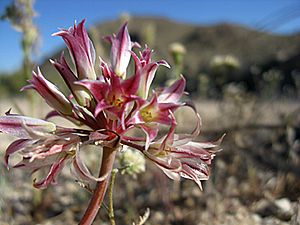Parish's onion facts for kids
Quick facts for kids Parish's onion |
|
|---|---|
 |
|
| Conservation status | |
| Scientific classification |
Allium parishii, also known as Parish's onion, is a special kind of wild onion. It's not very common to find. This plant grows naturally in the warm, dry Mojave Desert and Sonoran Desert regions. You can find it in parts of California and Arizona.
Contents
Discovering Parish's Onion
Parish's onion loves to grow in sunny, rocky places. It prefers slopes that are dry and open. This unique plant is usually found at high elevations. It grows between about 900 and 1400 meters (or 2,950 to 4,600 feet) above sea level.
Where It Lives
This wild onion is a desert plant. It makes its home in the Mojave Desert and Sonoran Desert. In California, you might spot it in San Bernardino, Riverside, and San Diego Counties. In Arizona, it grows in Yuma and Mohave Counties. These areas are known for their hot, dry climates.
What Parish's Onion Looks Like
Parish's onion has some interesting features that help it survive in the desert.
Its Underground Bulb
This plant starts from a small, reddish-brown bulb. A bulb is like a tiny underground storage unit for the plant. It's just a little over a centimeter long. This bulb helps the onion store water and nutrients.
Stems and Leaves
From the bulb, a tall stem called a scape grows upwards. This scape can reach about 25 centimeters (almost 10 inches) tall. Parish's onion usually has only one leaf. This leaf is shaped like a cylinder and is often longer than the stem itself.
Its Flowers
At the top of the scape, you'll find a cluster of flowers. This cluster is called an umbel. An umbel can hold up to 25 flowers. These flowers are a pale pink color. They have thin lines on them that look darker. Each flower has narrow petals, called tepals, that are about one to two centimeters long. The parts of the flower that hold pollen, called anthers, are yellow. The pollen itself is also yellow.


